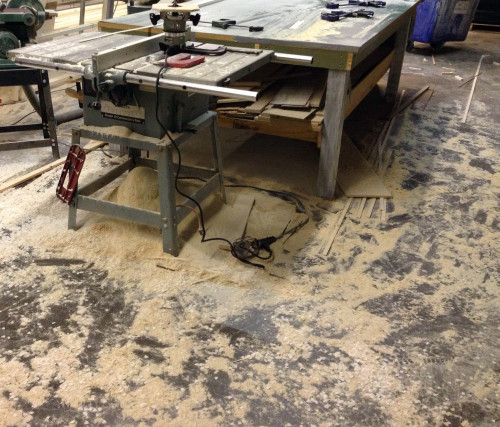Sawdust happens. If you are a prop carpenter, or you do any sort of carpentry in your shop, you will produce sawdust. There’s been plenty written about maintaining the dust in your shop; that is, providing adequate ventilation in your shop, hooking your tools up to dust collectors, hanging dust filters above larger power tools, and wearing dust masks when necessary. That’s all important, but this post is about dealing with the dust that is left. Sawdust creates four hazards:
- Slip hazard
- Health hazard
- Fire hazard
- Tool damage
Slip hazard
When you have a fine layer of sawdust on the ground, it reduces your traction. It is challenging enough to run a full sheet of plywood through a table saw. Don’t compound the struggle with slipping and sliding around on the floor. On lighter-colored floors, a thin layer of sawdust can be almost invisible and still cause slips and falls.
Health hazard
When you allow dust to hang around, everytime you drop a piece of wood or a prop, you will raise a cloud of dust. A lot of tools, especially routers and sanders, kick out a stream of air which will also blow sawdust into the air, and ultimately, into your lungs.
Fire hazard
Ideally, your shop will be set up for seperate metal and wood areas. In reality, this is not always possible, especially with larger props which cannot be moved to the metal area, or props constructed with both wood and metal. Grinding throws out hot sparks which disappear quickly, but if they find a pile of easily-combustible sawdust, they may begin to smolder and even catch fire. More dangerous is welding around sawdust. I’ve seen plenty of small fires begin from the johnny balls that fly out of a welder and roll into a pile of dust.
Tool Damage
All wood, even kiln dried, contains a minute percentage of moisture. When you turn the wood into dust, it allows the moisture to be released more easily. If you let even a thin layer of sawdust remain on your tools, the moisture will eventually begin to rust the metal parts. It makes no sense to spend hundreds or thousands of dollars on a tool with a precision-machined metal table only to let sawdust rust it away into a rough surface; especially when it takes about two seconds to brush the sawdust off.






